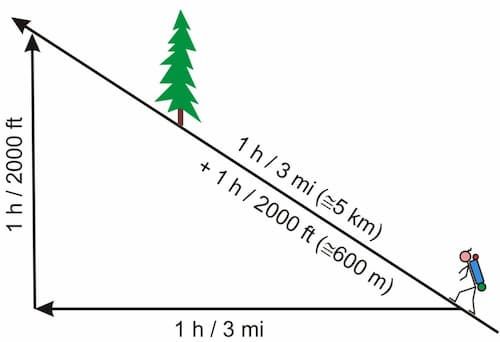One of my first questions and thoughts when I started this process was around what the average mileage a thru hiker will travel per day. Since this is a more crazy question than I first suspected I chose to write about it for the next person.
What is the Average Thru Hike Miles Per Day Expectation? This is typically 8-20 miles per day which will depend highly on the terrain, weather, and how close to town they may be. While out on the trail most will be aiming to reach a minimum of 16 miles per day after they achieve their trail legs.
Now that we have the expectations of what miles the average thru hiker will want to cover daily we should look into what the first couple weeks on trail look like for speed as many will overexert and cause themselves injury before ever getting going.
What About The First Week Or Two On Trail?
For most people choosing to take on a thru hike they are less than optimally trained for hitting long hard miles up front. This approach will frequently lead to massive leg issues from shin splits to torn muscles.
Instead I personally feel the smarter approach is to go slow and build up your legs, you have used them your whole life but never in this capacity. Most people walk, on average, less than 10,000 steps per day, this works out to basically less than 3 miles per day traveled.
So if you hit the trail trying to hike at super fast pace you can and will cause yourself lots of issues that you will need to recover from. Instead take the balanced approach of aiming for an achievable mileage at first, believe me you will make it up later as you gain hiking legs.
What is the Hiking Speed Formula?
When you are trying to look at your hiking speed you will see many peoples answers to their own speeds but those will be influenced by shorter legs, longer legs, overall health and much more.

What is the Naismith hiking speed formula? The Naismith formula is to help figure out how long your hiking route will take. It requires some simple math where you calculate an average of 3 miles per hour of walking then you add 30 minutes per 1,000 feet of elevation gain.
You can use this formula for any trail to see what your expectations daily would be for time and distance. This can help you plan out the days for travel on a thru hike, not that I would plan the whole thing but to understand the time and distance you may cover when you get out there in the first week.
What Is the Average Hiking Speed for Hikers?
This is very difficult to track as most trails are the most fluctuating sections of land you have ever seen, going up and down consistently as opposed to a road or walking path in town.
What is the average hiking speed for hikers? The average hiking speed for most hikers will average about 2-3 miles per hour or (3.2-4.8 km/h). This speed is dictated by weight carried and terrain being covered and your speed doesn’t greatly increase over time, typically the length of time you hike will increase to get more miles.
If you are out on a day hike then you may be able to maintain a faster speed than this, but for most hikers with a pack you will need to watch footing and take a more cautious approach. For those people they may achieve as fast a speed as they feel safe moving at while not becoming injured.

The issue is your relative speeds will slow dramatically on a given trail based on the incline and decline of the paths, I have assembled the overall list below from people talking about walking speeds then putting through the hiking conversion.
How Many Miles Can be Hiked in a Day?
The number of miles per day is many times worn as a badge of strength, durability, and possibly stubbornness. It can show how you have built your trail legs and totally change your approach to how far you may want to hike in a day.
How many miles can be hiked in a day? Since most hikers can average about 3 mph the total mileage will vary based on the overall elevation gained on the hike and the total number of hours you are able to hike. Most will average 8-10 hours of hiking which would yield the possibility of 24-30 miles with solid trail legs.
Now if you are just starting to hike or thru hike this miles number will be much lower while you build up your strength. While you use your legs every day in normal life you aren’t walking 8 hours a day for 99% of people this will be a new strain on your legs.
How Far Can the Average Person Hike in a Day?
When most people look to start taking hikes they aren’t in hiker shape, you may be strong in the gym and the treadmill but walking on hiking trails is much different for many people.
How far can the average person hike in a day? Most day hikers will look at a 10-12 mile round trip as an average hiking distance to travel in a day with a 6 mile hike in followed by a 6 mile hike out.
Should you choose to be out hiking with children then you should look to cut the overall distance in half and aim for 5-6 miles. This is unless you want to add to your own difficulty and carry them the final few miles once they are out of energy and focus.
What Are the Average Miles Hiked Per Day on the Appalachian Trail?
There is typically an escalation over time on the trail where you will begin to increase your overall mileage you can do in a day. Most starting hikers with very little trail time and experience will begin their hike averaging 8-10 miles per day.
As they get into the end of month one this will begin to increase up to 12-16 miles per day as the trail legs begin and the leg muscles get stronger. Many hikers may even move past this level and get to the 20-25 miles per day churning out distances that would make new hikers astonished!
While the Appalachian Trail doesn’t have the high peaks of the PCT or CDT it has more overall mileage up and down constantly throughout the entire hike distance.
What Are the Average Miles Hiked Per Day on the Pacific Crest Trail?
Similar to the Appalachian Trail above you will have a similar mileage but the challenges are a little different. When you start the PCT you are in the desert and will have water be primary concern and may force you to do less miles or more miles to get to a water source.
Then once you make it past the desert you look into the Sierra mountains which changes into steep ascents which will limit your mileage due to the overall elevation gains. This will impact your ability to manage fast and long miles until you move on from the Sierras.
These speed limiters will occur as you move into and out of the mountains the entire way in Oregon and Washington, though there will be equal elevation losses which may help increase your speeds after you summit.
What Are the Average Miles Hiked Per Day on the Continental Divide Trail?
While the AT and PCT have trials to manage over the length the CDT is not as much a formalize trail as a guiding direction and this can mean having to put in far more miles to get through rough areas at times.
The miles for hiking are still like the AT listing above as those are average hiking miles, elevation gain is where you will lose distance the most from my research on the CDT, along with going off track and the wrong direction.
This also means the Divide trail is the most exciting one to hike as it is far more remote and much more skill based, you will want to know that it may not be a smooth trip for you like you would get on the more established trails of the AT and PCT.
Final Thoughts on the Average Thru Hiker Mileage Per Day
Getting out is amazing for you as it helps you clear your mental fog and clear your brain of all the stresses of the busy world around you. Personally it is a way for me to get away from all my mental fatigue and to focus on nature and just rebalance.
I would recommend everyone get out and hike much more as it will help you in your life to disconnect from the electronics that rule it today and show you that it is very possible to survive without Facebook updates hourly!
